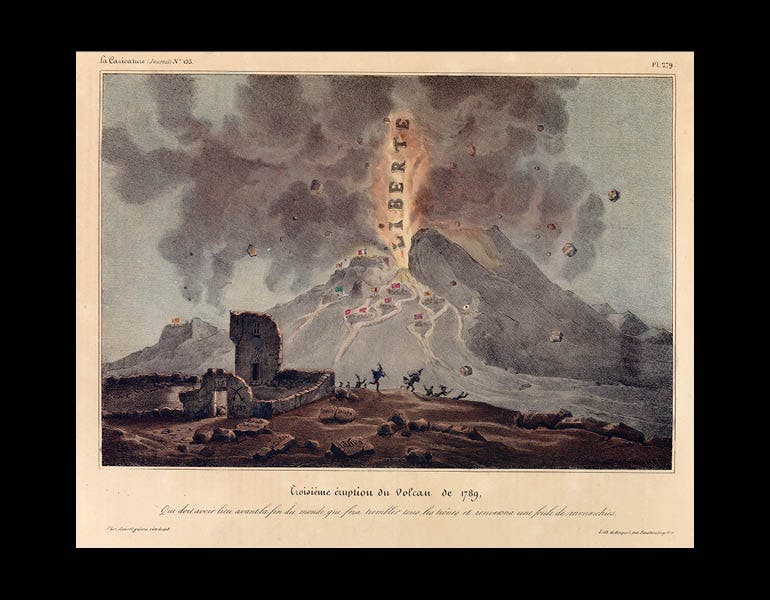
The Last Days of Pompeii: Decadence, Apocalypse, Resurrection
Tags for: The Last Days of Pompeii: Decadence, Apocalypse, Resurrection
- Special Exhibition
Sunday, February 24–Sunday, July 7, 2013
Location: The Kelvin and Eleanor Smith Foundation Exhibition Hall

Third Eruption of the Volcano of 1789 (Troisième éruption du volcan de 1789), 1833. Auguste Desperret (French, 1804–1865). Lithograph, hand-colored with watercolor; 34 x 24.5 cm. Image courtesy University of Pittsburgh Libraries
About The Exhibition
Pompeii and the other ancient cities destroyed and paradoxically preserved by the eruption of Mount Vesuvius in ad79 are usually considered the places where one can best and most directly experience the daily lives of ancient Romans. Rather than presenting these sites as windows to the past, this exhibition explores them as a modern obsession. Over the 300 years since their discovery in the early 1700s, the Vesuvian sites have functioned as mirrors of the present, inspiring artists—from Piranesi, Ingres, and Alma-Tadema to Duchamp, Rothko, and Warhol—to engage with contemporary concerns in diverse media. This international loan exhibition is co-organized by the J. Paul Getty Museum and the Cleveland Museum of Art.
For more information, follow @LastDaysPompeii on Twitter.
Ticketed Exhibition
Adults: $15; college students (with valid student ID) and seniors (65+): $13; children (6–17 yrs.): $7; children 5 and under: free; members: free.
Featured Art
 Glaucus and Nydia, 1867. Lawrence Alma-Tadema (British, 1836-1912). Oil on wood panel; 39.00 x 64.30 cm. The Cleveland Museum of Art, Gift of Mr. and Mrs. Noah L. Butkin 1977.128
Glaucus and Nydia, 1867. Lawrence Alma-Tadema (British, 1836-1912). Oil on wood panel; 39.00 x 64.30 cm. The Cleveland Museum of Art, Gift of Mr. and Mrs. Noah L. Butkin 1977.128 Mount Vesuvius, 1985. Andy Warhol (American, 1928–1987). Screenprint on linen, hand-colored with acrylic; 72.4 x 81.3 cm. The Andy Warhol Museum, Pittsburgh; Founding Collection, Contribution the Andy Warhol Foundation for the Visual Arts, Inc. © 2012 The Andy Warhol Foundation for the Visual Arts, Inc. / Artists Rights Society (ARS), New York
Mount Vesuvius, 1985. Andy Warhol (American, 1928–1987). Screenprint on linen, hand-colored with acrylic; 72.4 x 81.3 cm. The Andy Warhol Museum, Pittsburgh; Founding Collection, Contribution the Andy Warhol Foundation for the Visual Arts, Inc. © 2012 The Andy Warhol Foundation for the Visual Arts, Inc. / Artists Rights Society (ARS), New York The Dog from Pompei, 1991. Allan McCollum (American, b. 1944). Cast fiber-reinforced Hydrocal; 53 x 53 x 53 cm. Courtesy of the Artist and Friedrich Petzel Gallery, New York. Photo: Lamay Photo.
The Dog from Pompei, 1991. Allan McCollum (American, b. 1944). Cast fiber-reinforced Hydrocal; 53 x 53 x 53 cm. Courtesy of the Artist and Friedrich Petzel Gallery, New York. Photo: Lamay Photo. Cheyney and Eileen Disturb a Historian at Pompeii, 2005. Lucy McKenzie (Scottish, b. 1977). Acrylic and ink on paper; 254 x 368.3 x 12.7 cm (framed). The Museum of Contemporary Art, Los Angeles, Purchased with funds provided by the Drawings Committee
Cheyney and Eileen Disturb a Historian at Pompeii, 2005. Lucy McKenzie (Scottish, b. 1977). Acrylic and ink on paper; 254 x 368.3 x 12.7 cm (framed). The Museum of Contemporary Art, Los Angeles, Purchased with funds provided by the Drawings Committee UNTITLED, 2002. Antony Gormley (British, b. 1950). Mild steel blocks; 45 x 189 x 53 cm (overall). Collection of Asher Waldfogel and Helyn MacLean. Photo: Stephen White, London. © Antony Gormley
UNTITLED, 2002. Antony Gormley (British, b. 1950). Mild steel blocks; 45 x 189 x 53 cm (overall). Collection of Asher Waldfogel and Helyn MacLean. Photo: Stephen White, London. © Antony Gormley Mount Vesuvius at Midnight, 1868. Albert Bierstadt (American, 1830–1902). Oil on canvas; 42.60 x 60.70 cm. The Cleveland Museum of Art, Gift of S. Livingstone Mather, Philip Richard Mather, Katherine Hoyt (Mather) Cross, Katherine Mather McLean, and Constance Mather Bishop 1949.541
Mount Vesuvius at Midnight, 1868. Albert Bierstadt (American, 1830–1902). Oil on canvas; 42.60 x 60.70 cm. The Cleveland Museum of Art, Gift of S. Livingstone Mather, Philip Richard Mather, Katherine Hoyt (Mather) Cross, Katherine Mather McLean, and Constance Mather Bishop 1949.541
The Last Days of Pompeii: Decadence, Apocalypse, Resurrection is organized by the Cleveland Museum of Art and the J. Paul Getty Museum. The exhibition is supported by an indemnity from the Federal Council on the Arts and the Humanities.
Related Content
The Last Days of Pompeii: Decadence, Apocalypse, Resurrection Exhibition Checklist
Tags for: The Last Days of Pompeii: Decadence, Apocalypse, Resurrection Exhibition Checklist
- Document

The Last Days of Pompeii: Decadence, Apocalypse, Resurrection Brief Bibliography (163 KB PDF)
Tags for: The Last Days of Pompeii: Decadence, Apocalypse, Resurrection Brief Bibliography (163 KB PDF)
- Document
